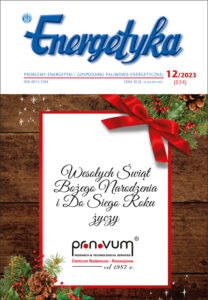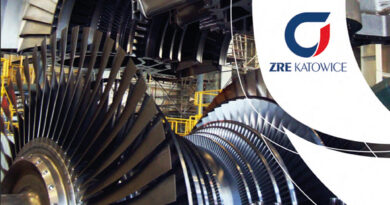December 2023, Issue 12 (834)
TABLE OF CONTENTS
BULLETIN OF PRO NOVUM
Waldemar Szulc
Necessary conditions for extending the operation of coal-fired units in the transition period
Jerzy Trzeszczyński
Project Power Units 2025+
Assumpions for the strategy for continuing the operation of 200 MW class power units (II)
Current status of the Project implementation
Kai van de Loo
Suspend coal phase-out – keep existing plants in operation and reactivate available capacities, give transition more time
Frank Biesinger, Huáscar Lorini, Mariusz Banaszkiewicz
Steam turbines for flexible operation
Jerzy Trzeszczyński, Marcin Hatłas, Wojciech Murzynowski
The application of digital twins to assess the technical condition of critical elements of 200 MW class units during the extension of their operation and adaptation to new operating regimes
Jerzy Raźny, Radosław Stanek
Benefits resulting from diagnostic supervision performed with the Prognoza PRO® System on the example of the BC-50 duoblock at Veolia Energia Poznań S.A.
Paweł Gawron, Wojciech Murzynowski, Bartosz Waligóra, Krzysztof Grzelak
Modern diagnostics – effective support in solving repair problems and extending the working time of pressure elements
Wojciech Merdalski
Diagnostics and availability of thermal power plants in the era of changes in the energy sector
XXV Symposium DIAGNOSTICS OF POWER EQUIPMENT AND INDUSTRIAL INSTALLATIONS
Safety and availability of power units and equipment during the transformation of the Polish power sector (II)
BULLETIN OF IASE
Antonina Kieleczawa, Klaudia Krawiec-Ziątek, Michał Białecki, Jerzy Drutko, Arkadiusz Fiń, Radosław Izakiewicz, Piotr Pietras, Roman Skakowski, Wojciech Szubert
Implemental and operational aspects of the DCS MASTER system
Bartłomiej Borkowski, Tadeusz Mączka, Piotr Szulc, Tomasz Tietze
Modelling of a RES hybrid generating system integrated with an energy store
Bartłomiej Borkowski, Radosław Izakiewicz, Mariusz Lipiński, Tadeusz Mączka, Roman Skakowski, Halina Pawlak-Kruczek, Michał Ostrycharczyk
„PLASMA CONTROL SUPERVISION” system for supervision of plasma installations on the example of a prototype installation for sewage sludge treatment
Agata Wirth–Ljungquist, Aleksander Iwaniak
Operational problems of a supercritical power unit with a fluidized bed boiler and their sources
OVERTIME LECTURE…
Bogumił Dudek
Ampere more important than Volta?
SUMMARIES
Waldemar Szulc
Necessary conditions for extending the operation of coal-fired units in the transition period
Article exploring the necessary actions needed to prelong the exploatation as well as gradual and safe extinction of the coal power plants during the transition period in polish energy system.
Jerzy Trzeszczyński
Project Power Units 2025+
Assumpions for the strategy for continuing the operation of 200 MW class power units (II)
Current status of the Project implementation
Continuation of the operation of 200 MW class power units has no rational alternative. It gives hope to cover the projected negative power balance in the Polish power system after 2025 and may ensure increase in generation from renewable sources, which will be safe for the National Power System. Meeting this challenge requires an urgent development of a strategy for the operation of 200 MW units, including in particular maintaining the technical condition at a level ensuring safety and availability, taking into account the increasingly regulatory nature of their operation, in the perspective of around 2035, as well as financing these units, and the expiry of support from the Capacity Market.
Kai van de Loo
Suspend coal phase-out – keep existing plants in operation and reactivate available capacities, give transition more time
While there are no fundamental doubts about the direction of the energy transition in Germany – much less the goal of achieving sustainability – the changes in the general circumstances dictating energy policy that have occurred in 2022 give rise to sound arguments in favour of suspending the coal phase-out agreed in Germany. Current law requires the completion of the exit “by no later than 2038”; the coalition agreement of the “traffic light government” expresses the hope that the process will be concluded “ideally as early as 2030.” But in reaction to the “new era” impacting energy policies in Germany and else-where and the acute natural gas emergency, the previously set path for the coal phase-out is already undergoing revision. Now that the use of natural gas as a reliable bridge from fossil fuels to the renewable energy era has proved to be illusory, the coal phase-out schedule should be suspended and modified for the moment. The complete shutdown of coal-fired plants cannot be justified until truly viable alternatives are in place. The disadvantages for climate protection invoked by climate activists would be relatively small, while the energy, raw material and regional economic advantages would be massive.
Frank Biesinger, Huáscar Lorini, Mariusz Banaszkiewicz
Steam turbines for flexible operation
The demand for more flexible operation of power plants has increased significantly in the last few years. Increased numbers of starts, operating hours and ramp rates result in accelerated lifetime consumption of the steam turbine components. Nowadays, one of the major tasks is to assess the capabilities of existing steam turbine units in terms of more flexible operation. New concepts are developed to allow improved flexible operation with associated thermal stress protection of components. New calculation methods support this approach and help to best utilize the remaining lifetime for future operation. The current lifetime status has to be established first and the remaining lifetime is then available to be utilized and distributed for future operation. The assessment of components is done by using the Finite Element Method with creep and transient calculations. Implementation of a state-of-the-art thermal stress control system allows adjustment of the stress calculator settings to the needs of the re-allocated remaining life. There are also options available to enhance flexible operation within an existing steam power plant, e.g. a reconditioning of the existing rotor with particular focus on the first blade groove or exchange an existing component for one with superior properties.
Jerzy Trzeszczyński, Marcin Hatłas, Wojciech Murzynowski
The application of digital twins to assess the technical condition of critical elements of 200 MW class units during the extension of their operation and adaptation to new operating regimes
A significant part of the Polish power system consists of units and devices that have been in operation for a long time. These have undergone multiple repairs and modernizations to extend their operational lifespan, improve efficiency, and comply with current emission limits. This particularly applies to the 200 MW class units. Due to the increasing share of renewable energy in the energy mix, it has become necessary to switch their operation mode to a more regulatory or even flexible one. This entails an increased number of start-ups, lower technical minimums, more frequent power output changes, and faster ramp-up. Ensuring safety and availability requires a precise identification of the remaining lifespan of critical components and their degradation during operation. These conditions can be met by utilizing parametric digital twins in diagnostic systems. These digital twins, operating within specialized software equipped with algorithms developed by Pro Novum specialists, can perform the functions of a comprehensive diagnostic system and operate remotely and are integrated into the unit’s operation process.
Jerzy Raźny, Radosław Stanek
Benefits resulting from diagnostic supervision performed with the Prognoza PRO® System on the example of the BC-50 duoblock at Veolia Energia Poznań S.A.
Diagnostic supervision at Pro Novum is treated as a system integrated with the operation of devices. It begins during diagnostics accompanying overhaul, and continues during the operation of devices. Advanced IT, analytical and digital technologies are used to update the assessment of the technical condition of elements with appropriate quality and to verify their durability forecast. Knowledge from the Prognoza PRO® program is a strong tool supporting the decreasing number of engineers involved in maintaining the technical condition of their production equipment, additionally in the conditions of continuous transformation of the energy industry. The paper presents the most important benefits of diagnostic supervision implemented after the last overhaul of the BC-50 duoblock at Veolia Energia Poznań S.A.
Paweł Gawron, Wojciech Murzynowski, Bartosz Waligóra, Krzysztof Grzelak
Modern diagnostics – effective support in solving repair problems and extending the working time of pressure elements
Long-term operation is not always associated with full recognition of technical problems that plague energy devices and reduce their reliability indicators. In a broader sense, knowledge about the current technical condition of devices is not always sufficient to plan the correct operation and renovation cycle. This is particularly important in an industrial plant, where the part related to energy/heat generation is inextricably linked and critical to the operation of the technological part of the works. The paper presents examples of the use of modern diagnostic and analytical methods to recognize the technical condition of the facility, determine the direct and indirect causes of the problem, along with defining the scope of corrective actions and modern methods of validating the concept and effects of repair.
Wojciech Merdalski
Diagnostics and availability of thermal power plants in the era of changes in the energy sector
Changes in the thermal and energy sector resulting from the move away from coal technologies influence changes in the strategy for maintaining production assets. Ensuring failure-free production of electricity and heat while limiting maintenance costs is a significant challenge. Ensuring the availability of electricity and heat sources in the final phase of operation requires the use of preventive actions and diagnostics, which should be aimed at solving possible problems.
Antonina Kieleczawa, Klaudia Krawiec-Ziątek, Michał Białecki, Jerzy Drutko, Arkadiusz Fiń, Radosław Izakiewicz, Piotr Pietras, Roman Skakowski, Wojciech Szubert
Implemental and operational aspects of the DCS MASTER system
Presented are implemental and operational aspects of the DCS MASTER automation system developed in IASE and continually improved for more than 30 years. Unquestionable advantages of this Polish automation system are its clear structure, modular construction and free scalability according to a user’s needs, simplicity of integration with other producers’ systems as well as realization of unconventional requirements of some users. Functional abilities of this system are permanently extended while graphical interfaces as well as engineering, editorial and configuration tools are continuously innovated that translates into competitiveness against automation systems proposed by foreign entities. System DCS MASTER has been implemented in Poland in many energy generating facilities and in numerous variants – from single process and operator stations in the form of touch panels to complex turn-key facility installations.
Bartłomiej Borkowski, Tadeusz Mączka, Piotr Szulc, Tomasz Tietze
Modelling of a RES hybrid generating system integrated with an energy store
Presented is a model of an RES hybrid system (wind-solar system) with an electrochemical energy store controlled by an elaborated algorithm. Carried out were simulations comprising winter and summer scenarios and showing differences in RES energy generation. The aim of the algorithm is to control an energy store in the way to minimize the energy draw on a power grid. Application of electrochemical stores enables elastic storage and use of electric energy diminishing the dependence on weather conditions and finally reducing the energy costs. At the moment works are conducted on integration of the control model with a real object that will help in development of more precise control algorithms, based on artificial neural networks, for RES units with energy stores.
Bartłomiej Borkowski, Radosław Izakiewicz, Mariusz Lipiński, Tadeusz Mączka, Roman Skakowski, Halina Pawlak-Kruczek, Michał Ostrycharczyk
„PLASMA CONTROL SUPERVISION” system for supervision of plasma installations on the example of a prototype installation for sewage sludge treatment
Presented is „PLASMA CONTROL SUPERVISION” system developed to supervise a prototype plasma installation for sewage sludge treatment. The system registers process parametres and enables the real-time control, visualization and filing of data. Whole content of this article focuses on the essence and abilities of the „PLASMA CONTROL SUPERVISION” system in effective conducting of the organic sewage sludge treatment processes. Results of experiments and regular duty operations carried out on a prototype installation by a team of scientists from Wrocław University of Science and Technology, Faculty of Mechanical and Power Engineering and the key personnel of IASE Sp. z o. o. make a basis for future implementation of the system on an industrial scale.
Agata Wirth–Ljungquist, Aleksander Iwaniak
Operational problems of a supercritical power unit with a fluidized bed boiler and their sources
Supercritical fluidized bed boilers are an example of a modern engineering solution using atmospheric furnaces with a circulating bed. Their advantage is primarily high coal combustion efficiency (approximately 98%) and low emissions of pollutants into the environment, including nitrogen oxides and sulfur oxides. Currently, there are over several hundred power units operating in Poland and around the world, for which the steam source is a boiler of this particular design. The paper presents operational problems of a supercritical power unit with a CFB 1300 fluidized bed boiler in the period 2017-2020. The elements of the installation that are particularly vulnerable to intensive destruction and damage have been indicated.




